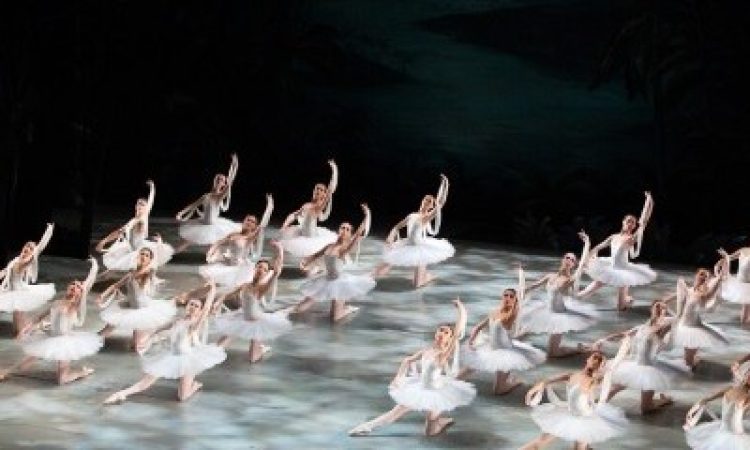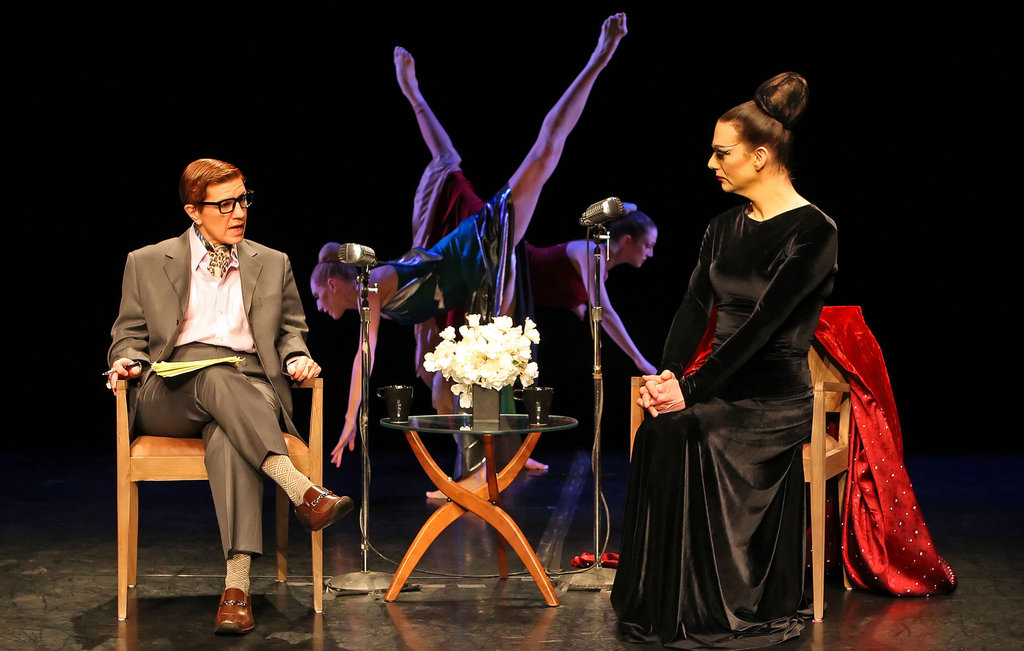The Bronze Idol from La Bayadère (chor. Marius Petipa, 1877) is one of my favorite variations in the classical ballet canon. When else do we get to see a male statue come to life in almost full nudity—painted head to toe in gold, no less? Ashton Roxander danced the variation brilliantly, in all senses of the word, in the performance I saw on Friday, March 6. The outside turns in attitude on plié-half point were kept to singles—steady, clean and buoyant—to contrast sharper hand gestures and other movements that seemed to transition the statue in and out of life even while it danced. But I couldn’t fully enjoy the variation because of the empty stage around the dancer. In productions of this ballet performed until recently, the stage was populated with many other bodies, most notably those of the idol’s worshipers, traditionally represented in brown-face. Angel Corella’s restaging, like others in recent years, addresses this offensive practice by eliminating those dancers. And yet, to me, the worshippers were there more powerfully in their absence. Orientalism haunted the stage.
A week before opening night, PAB held an open forum at Pennsylvania Academy of the Fine Arts to discuss the now-troubling essentialism and appropriation of this ballet. La Bayadère is about an “Indian” temple dancer (Nikiya) who fights for the warrior she loves (Solor) despite numerous obstacles, including her own death. The ballet has familiar tropes of late nineteenth-century Western European orientalism. Set in a fictional space imagined as India at some point in history before the coming of the British Empire, it incorporates musical, visual, and choreographic references to various cultures and traditions of South Asia, East Asia, and the Middle East. Although the manner in which these elements are combined and represented may certainly suffer from essentialism and occasionally be degrading (with respect to the fakirs, for instance, who scuttle across the stage like timorous apes), we should recall that Petipa performed extensive research in an attempt to portray the richness of these (to him) foreign cultures. This is evidenced even in the libretto (Sergei Khudekov), which contains substantial detail on the religions and traditions invoked by the characters, information which seems to have been obscured over time. At the PAFA event, Corella described measures he had taken to mitigate some of the most offensive aspects of the ballet. These included consultations with Phil Chan of Final Bow for Yellowface, removal of the temple dancers mentioned earlier, and rechoreographing several of the hand positions and gestures used throughout the ballet, based on input from Pallabi Chakravorty, an Indian dance scholar at Swarthmore College, to better align them with actual practice.
I was perturbed at this forum by some speakers’ comments—despite the best intentions of inclusivity—tending to characterize contemporary cultural geographies as fixed and binary. In truth, ballet dancers do not have a single, immutable culture from which they depart to play characters on stage. Rather, their culture is performed and hence constituted every day by various means, including the movements they execute in technique class and rehearsal. A Venezuelan dancer who happens to be “white” likely has no more knowledge of medieval German peasantry and supernatural spirits than she has of precolonial temple dances from India, but she dances a villager and a wili in Giselle all the same. However, I was more deeply troubled by the disrespectful manner in which some audience members criticized the company for not taking a more radical approach.* Since then, controversy over the ballet has intensified. Among other things, a subsequent PAB event unrelated to La Bayadère held at Parkway Central Library was hijacked by audience members who protested any support of the ballet or the company given its decision to stage the ballet, and a petition signed by several hundred people has been circulating, demanding that the company cancel all performances and atone for its “sins.” [As this article goes to press, PAB has announced cancellation of La Bayadère performances on Mar. 12-15, because of the coronavirus.]
All of this weighed on me as I watched the performance, on top of my hyperawareness, as a dance historian, of the ballet’s problematic exoticism. I did notice the changed hand positions and salutations. I also noticed the supplemental insert to the program addressing the ballet’s Othering. And the life-sized portrait of Solor used by Gamzatti in the palace scene to humiliate Nikiya was, like the company’s publicity photograph of the Bronze Idol, produced before the gesture rechoreographing and thus depicted the figure in a less realistic pose. These, like the haunting empty space around the Bronze Idol, trace the persistent impacts of colonialism. As parts of the history of this ballet, and of dance, they must be acknowledged and questioned; nothing good comes of repression. The discomfort I experienced during the performance was thus productive, and not to be avoided. The Bronze Idol is not just a statue, after all. It is a portrayal of an “Indian” deity, with all the violence such representation encodes.
That said, I find the hostile criticism recently directed at Corella, PAB, its dancers, and representatives of other organizations with which the company is affiliated (perhaps exacerbated by the current political climates here and in India) to be misplaced. La Bayadère is by no means unique in the classical ballet canon in its orientalist approach. Almost all classical ballets draw on the exotic in some dimension. Is ballet’s romanticization of the peasantry, the essentialization of Spain and Eastern Europe, or the glorification of monarchy any less offensive than its appropriation of Indian cultural practices? What about its perceived misogyny? Or antiblackness? How to deal with offensive and marginalizing aspects of past works is a serious and complicated issue that all classical performing arts from around the globe must address.
La Bayadère is best-known for its second act , which takes place in the “Kingdom of the Shades,” a mysterious realm inhabited by ethereal creatures, presumably dead women, in white tulle. Their entrance is reputed as one of the most difficult sequences in the canon for the corps de ballet: a series of 39 choreographic units in which each shade steps, in arabesque, across the stage, one after another, in near perfect synchrony. At this performance, the dancers rose to the challenge with admirable precision and requisite stamina, though I would have preferred the sequence to flow more fluidly (it was sharply segmented here) to complement the mesmeric quality of this passage in the Ludwig Minkus score. The second portion (the bourrées in place) was truly captivating, however, and illuminated what I find to be a special moment in classical ballet: when dancing seems entirely unmotivated by narrative and is slow enough to allow the spectator to reflect while watching. Whereas uniformity in this scene is usually stressed, for me at this performance, the slow, repetitive choreography revealed the subtle differences in the dancers’ corporeal articulations and made me feel paradoxically connected to these shades even though they never looked directly at me. I wondered—for some time—why they were moving in such spellbinding unison and what they were all gazing at so intently to their upper right.
One could, of course, avoid some of the offensive content of the ballet by performing only this so-called abstract portion (and this has been done, though probably not for this reason). But abstraction is not necessarily neutral, aesthetically or politically. More to the point, this moment would lose its magic without its placement in the whole ballet, which offers it to the viewer as something between a contrite lover’s drug-induced dream and a vision of the afterlife. Indeed, the scene’s power derives partly from musical, costuming, and choreographic motifs from earlier in the ballet that find full fruition here. In this regard, Corella’s provocative changes—the elimination of the original ending (cataclysmic destruction meted out by the gods), and the slow, processional exit of Nikiya (Dayesi Torriente) and Solor (Sterling Baca) via the same ramp from which the shades entered, to a variation on the shades’ musical theme—completed the narrative more elegantly by tying it to the first act. This restaging thus makes better use of the more problematic first half of the ballet and captures the ambiguity that makes the ballet so unique. This is to say nothing of the rest of the choreography, which manifests a different kind of beauty than typically found in the ballets of this period, likely owing to its cultural influences/appropriations (for instance, the weighted and rhythmic bouncing in the scarf dance of the Djambes, or Nikiya’s death dance and its enchanting serpentine balances and cambrés that foreshadow her demise).
I commend Corella and PAB for facing the ballet’s disturbing issues directly and instigating this discourse while preserving the work’s value in the classical repertoire. Many of the modifications in this restaging were, I find, improvements, and the company’s commitment to rethinking various aspects of the ballet are promising. And, I heard directly from PAB artists that they very much enjoyed and appreciated Dr. Chakravorty’s involvement, for it added depth to their understanding of the ballet, its cultural references, and their characters. Their thinking and dancing have been enriched, and their relationship to the past problematized, as a result of these initiatives—as have mine as their spectator. Changes like that don’t result from erasure.
*It bears noting that this production, according to Corella, is a restaging. This is different from a reworking (a substantially new choreography that refers to a preexisting work in order to challenge or subvert it) or a reenactment (a work that reproduces an earlier choreography while foregrounding its historical remove and the current work’s relationship to the past). The purpose of this restaging is thus to modify the work as performed historically (the ballet has been revived and reinterpreted in several “versions” since the beginning of the twentieth century) to bring the ballet more in line with contemporary tastes and perspectives, while maintaining the integrity of the original.
La Bayadère, Pennsylvania Ballet, Academy of Music, March 5–15.






